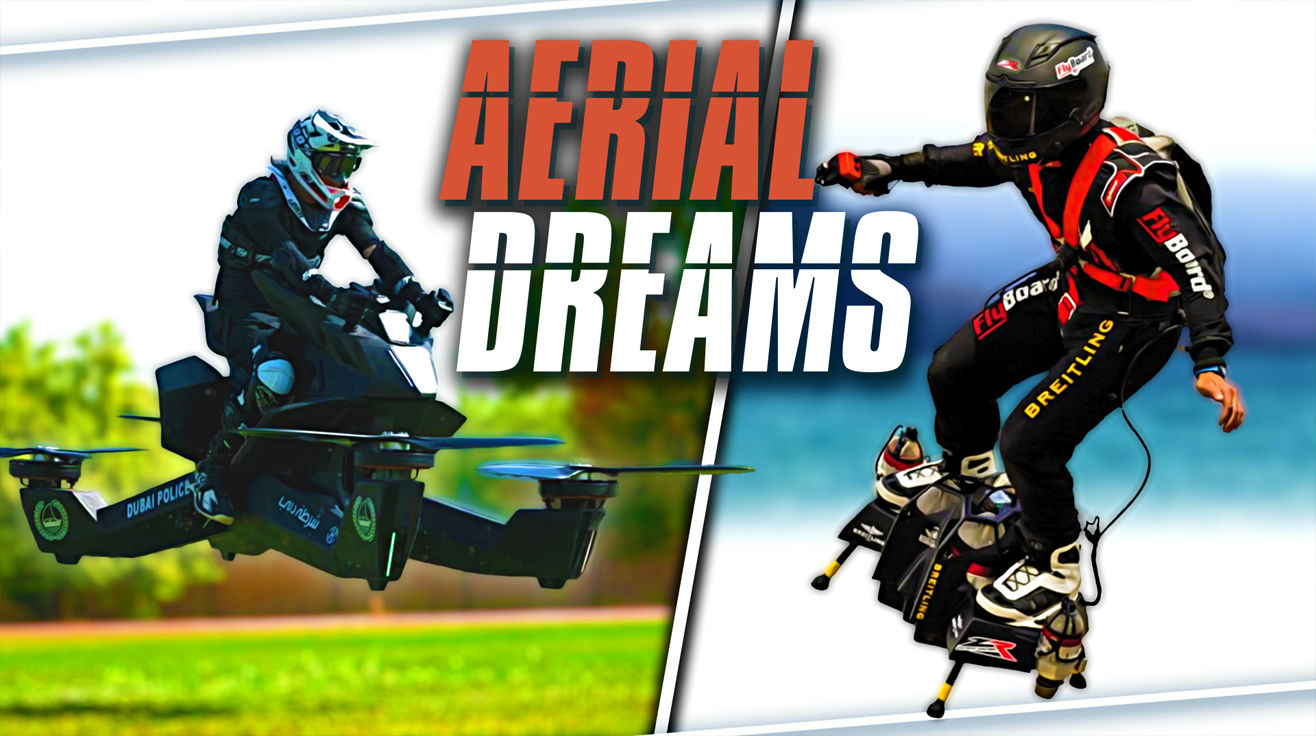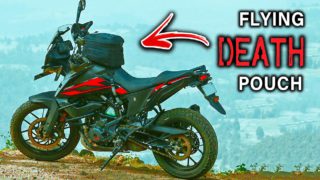Forget traffic jams. The next frontier in personal transportation isn’t on the ground — it’s above it. Remember how The Jetsons promised flying cars by the 2060s? Well, they were off by about 40 years. Personal flight tech isn’t just coming; parts of it are already here, turning what was once sci-fi fantasy into something you can actually buy… if you’ve got the cash.
Electric VTOL technology has slashed noise levels compared to the ear-splitting whine of helicopters. Better yet, operating costs have plummeted from $350 to under $50 per hour. That morning commute that eats an hour of your life in bumper-to-bumper misery? It could soon be a breezy 15-minute journey with a view that makes Instagram influencers jealous.
23. Hoverbike S3

The Hoverbike S3 is what happens when electric bikes decide they’re done with gravity. This carbon-fiber marvel weighs 251 pounds — about as much as a heavyweight boxer — yet zips through the air at 59 m/h. Dubai police already use these for rapid response, reaching scenes three times faster than ground units. It’s like having a motorcycle that can take shortcuts over buildings.
Flying at 5 meters keeps you in that sweet spot — high enough to clear traffic but low enough to avoid annoying aviation authorities. The best part? You don’t need a pilot’s license that costs more than a semester of college. A 5-day certification gets you airborne, thanks to triple security systems that keep novice pilots from accidentally recreating scenes from Fast and Furious.
22. Icon A5

The Icon A5 is the kayak of airplanes — if kayaks could fly at 109 m/h and fold up for storage in your garage. This carbon-fiber amphibious aircraft democratizes flight with a Sport Pilot License that requires half the training time of traditional pilot certifications. For weekend warriors who daydream about island-hopping, this is your new obsession.
The 100-horsepower Rotax engine sips fuel like a hybrid car, costing roughly $50 per hour to operate — less than a fancy dinner date. Land on a lake for a private beach day, then hit a runway to grab lunch in the next state over. The whole-aircraft parachute costs an extra $15K on top of the $189,000 base price, but can you really put a price on being able to tell your Tinder date you flew yourself to dinner?
21. Jetson 1

The Jetson 1 brings drone tech to human scale, letting you zip through the air like you’re playing a video game with your actual body. Its 891 lbs aluminum frame qualifies as an ultralight aircraft in the US, putting it in the same regulatory category as advanced kites. No pilot’s license needed — just the willingness to trust your life to eight electric motors.
This personal sky-rider accelerates to 62 m/h in 5 seconds — faster than most sports cars, without the traffic to slow you down. The 20-minute flight time is just enough for a quick commute or to make your neighbor spill coffee all over themselves when you land in your driveway. The built-in safety features include obstacle detection that prevents you from becoming an expensive lawn ornament on the side of a building. For a closer look at solo aviation, explore more mini personal aircrafts redefining personal flight.
20. Palv Liberty

The Palv Liberty is the transformer toy you wanted as a kid, sized up for your midlife crisis. This road-legal vehicle hits highway speeds of 99 m/h, then transforms into a gyrocopter in 10 minutes — about the time it takes to find decent parking in most cities. With a 248 miles air range, you could fly from LA to Vegas without the soul-crushing desert traffic.
After landing, simply fold in the rotors and drive straight to your destination. No awkward Uber rides from small airports or leaving your precious flying machine in sketchy hangars. Yes, you’ll need both licenses, but the company offers a conversion course that’s shorter than binge-watching a season of Stranger Things. When parked in your garage, nobody would guess it’s anything but an oddly shaped car — until you decide to skip rush hour by taking the aerial express lane.
19. Martin Jetpack

The Martin Jetpack was what happened when engineers asked, “What if firefighters could fly?” Two ducted fans powered by a gasoline engine lifted pilots up to 760 meters high — taller than most urban skyscrapers. At 24 m/h, it wasn’t winning any races against Elon’s latest Tesla, but it could fly for 28 minutes and cover 12 miles without roads or traffic lights.
Though the company closed shop in 2019, the technology proved that personal jetpacks aren’t just for James Bond movies. The ducted fan design solved the “getting burned by exposed jets” problem that plagued earlier attempts, much like how smartphones fixed the “having to carry a separate camera, map, and phone” problem of the 2000s.
18. Flyboard Air

The Flyboard Air is what happens when a snowboarder decides gravity is optional. This jet-powered hoverboard can rocket riders up to 1.8 mile high — about ten times the height of the Statue of Liberty. With speeds touching 93 m/h, it’s faster than most highway traffic, though with considerably more wind in your face.
Unlike bulky aircraft with complicated controls, the Flyboard Air responds entirely to body movements, similar to a skateboard. This intuitive approach comes with a steep learning curve, however — imagine trying to balance on a powerful fire hose while wearing rocket boots. The tech gained international fame after crossing the English Channel in 2019, proving it wasn’t just another viral video stunt but legitimate transportation tech with surprising range and reliability.
17. Pegasus E

The Pegasus E solves the electric aircraft’s biggest headache — limited range — by taking a hybrid approach that’s as practical as it is clever. Like a flying Prius, it combines electric motors for takeoff with fuel-driven generators for cruising. The result? A 186 mile range that lets you skip between cities without the range anxiety that plagues electric vehicles.
With a flight duration of up to 3 hours, it outlasts pure electric alternatives by a factor of three or more. The cherry on top? It runs on regular pump gas, not some exotic fuel that costs more than vintage champagne. Available in one to four-passenger models, it’s sized for everything from solo commuting to family trips, making it the Swiss Army knife of personal aircraft.
16. ArcaBoard

The ArcaBoard tackles the “last hundred yards” problem with 36 electric fans that generate enough lift to hover over practically any surface. Think of it as the ultimate all-terrain vehicle — it glides over water, sand, mud, or broken pavement that would stop even the burliest SUV in its tracks. It’s like having your own magic carpet, if magic carpets were loud and needed charging.
A full charge gives you about 6 minutes of hover time — perfect for crossing that flooded street or impressing people at the beach. Recharging takes 6 hours with standard equipment or 35 minutes with the optional supercharger that costs about as much as the board itself. While it won’t replace your daily driver, it fills the gap where conventional vehicles surrender to rough terrain, making it ideal for coastal properties, disaster recovery, or just making everyone at the skate park question their life choices.
15. Joby Aviation Air Taxi

Joby Aviation’s air taxi is building the Uber of the skies, minus the surge pricing and chatty drivers. This five-seater electric VTOL whisks passengers at speeds up to 200 m/h while producing less noise than your neighbor’s leaf blower. A one-hour ground commute shrinks to a 10-minute hop that feels more like a theme park ride than transportation.
The company has completed over 1,000 test flights and secured pathways to FAA certification, putting them ahead in the air taxi race. Their partnership with parking garage operators to create rooftop “skyports” solves the “where do these things land?” question that plagues urban air mobility. The goal? Pricing comparable to premium Uber rides, but with views that make the extra cost worth every penny.
14. Nisus Aero

The NisusAero brings the “starter airplane” concept to more pilots through clever engineering and a range of options that won’t require a second mortgage. Reaching speeds of 121 m/h, it’s quick enough to make regional travel practical while maintaining fuel efficiency that makes traditional aircraft owners green with envy. With a 310 mile range, you could fly from NYC to Boston without stopping for expensive airport fuel.
Available in standard, sport, premium flavors, it’s the aircraft equivalent of car trim packages. The premium version sports a muscular 160 horsepower engine that climbs like a homesick angel. Starting at $170,000, it costs less than many luxury cars while providing transportation that ignores traffic jams entirely. For the price of a loaded Tesla, you get European safety certifications and modern avionics that keep you safer than most cars on the highway.
13. Drone Champions League Manned Aerobatic Drone

The Drone Champions League has supersized drone racing by putting humans in the cockpit of these agile flying machines. Their manned aerobatic vehicle costs over a million dollars — about the same as a small apartment in Manhattan — but delivers capabilities that make conventional aircraft look like they’re flying through molasses. It’s the aerial equivalent of Formula 1, where extreme performance drives innovation that eventually trickles down to consumer products.
Pilots can perform maneuvers that defy physics, including loops, rolls, and inverted flight that seem to defy physics. The dual-control system allows operation from either the cockpit or ground station, making it the perfect training platform with a safety net built in. While you won’t commute in one anytime soon, the technology is already filtering into commercial craft, particularly in safety systems that make everyday flying more accessible.
12. Zapata Air Scooter

The Zapata Air Scooter brings the familiarity of motorcycle controls to the world of vertical flight. If you can ride a motorcycle, you’re halfway to piloting this aerial transport. The handlebars work much like those on a street bike, with added controls for altitude — think of it as a motorcycle with an extra dimension of freedom.
Its electric motors generate about as much noise as an electric car, allowing operation in areas where helicopters would get noise complaints faster than a 3 AM house party. The zero-emission system keeps operating costs below $20 per hour — cheaper than taking an Uber across town during rush hour. It’s the perfect blend of familiar controls and new capabilities, like when touchscreens first appeared on phones but kept enough buttons to ease the transition.
11. Klein Vision’s Air Car

Klein Vision’s Air Car spent a decade in development before becoming the first certified transforming vehicle that actually works as advertised. This two-seater transforms from road car to aircraft in just 3 minutes through an automated sequence that’s more reliable than most smartphone apps. If something goes wrong mid-flight, the advanced auto-landing system brings you safely back to earth — no pilot heroics required.
After receiving official certification in 2022, it cleared the regulatory path for similar vehicles to follow, like how the first iPhone established what smartphones could legally do. Powered by a BMW engine, it cruises at 105 m/h in flight with a range of 621 meters — enough to cross several states without refueling. When folded for road use, it fits in normal parking spaces without screaming “I’m from the future!” to everyone at the grocery store. If you’re fascinated by these hybrids, don’t miss our rundown of astounding flying cars that could revolutionize travel.
10. Renault Air 4 Flying Car

The Renault 4 flying car proves traditional automakers aren’t sleeping on the aerial mobility revolution. This concept marries drone technology with the iconic Renault 4 body — like putting your grandfather’s vintage watch mechanism into a smartwatch. The carbon fiber frame and massive 22,000 ampere battery provide the muscle needed for sustained flight without sacrificing the classic design that gives it instant recognition.
The four propeller units each generate 209 lb of thrust — enough to lift a professional football player. With a total payload of 1845 lb, it carries passengers and luggage as easily as its ground-bound ancestors. Though still in development, this approach shows how established manufacturers can accelerate the transition to flying cars by leveraging existing supply chains and production expertise — potentially cutting years off the development cycle compared to startups building everything from scratch.
9. Aeromobil 4.0

The Aeromobile 4.0 represents one of the most refined iterations of the flying car concept after a decade of intensive development. This Slovakian marvel transforms from sleek road vehicle to functional aircraft in under three minutes using a proprietary system that’s undergone over 10,000 test cycles for reliability. Powered by a BMW 1.6L engine, it achieves 160 km/h on highways and accelerates to an impressive 111 m/h in the air. The carbon-composite body keeps weight under 2, 2,204 lb while providing structural integrity for both driving and flying.
With an aerial range of 664 miles and 323 mile road range, it offers genuine multi-city capability without switching vehicles. Its wings and tail fold elegantly into the vehicle profile when driving, preserving its aerodynamic silhouette and allowing it to park in standard spaces. After receiving its official certification in 2022, the company has secured over 70 pre-orders at approximately €300,000 each, demonstrating serious market interest despite the specialized licensing requirements.
For wealthy commuters tired of sitting in traffic when they could be soaring above it, the Aeromobile delivers a viable alternative that works within existing infrastructure rather than requiring entirely new systems.
8. Skypak V1

The Skyak V1 brings steampunk aesthetics to functional aircraft design, like if Wes Anderson directed Top Gun. Its welded aluminum frame provides modern strength while maintaining the visual appeal of early aviation from the barnstorming era. The wooden propellers aren’t just for show — they deliver surprisingly efficient thrust while adding distinctive character you won’t find on carbon-fiber everything else.
A 112 horsepower engine provides power-to-weight performance that matches many contemporary ultralight aircraft, despite the vintage appearance. The base aluminum version stays airborne for about 2 minutes — perfect for air shows and demonstrations — while the carbon fiber variant extends flight time to nearly 30 minutes for practical recreational use. This blend of heritage design with modern materials attracts collectors looking for something with more personality than the typical white composite aircraft that dominate today’s airfields.
7. Micron 115

The Micron 115 delivers aerial freedom through regulatory judo, carefully engineered to sidestep the most restrictive aviation rules. Weighing under 253 lb — less than two average adults — it qualifies for ultralight classification in most countries. This clever positioning eliminates the need for pilot certification or registration paperwork that makes aircraft ownership feel like applying for a mortgage.
With speeds up to 222 m/h and range extending to 62 miles per tank, it offers practical day-trip capabilities without the traditional barriers to flight. Maintenance is simple enough that owners can handle it after a brief training course, similar to how early personal computers were designed for user servicing. By removing the licensing hurdles, the Micron 115 does for personal flight what budget airlines did for commercial travel — making it accessible to people who previously considered it out of reach.
6. Gravity Industries Jet Suit

The Gravity Industries Jet Suit is the closest thing to becoming Iron Man without being Robert Downey Jr. This wearable flight system attaches directly to the pilot with five micro gas turbines that provide enough thrust to lift an adult vertically and zoom across challenging terrain at speeds up to 31 m/h. It’s like having a personal roller coaster you can wear to work.
With the ability to reach altitudes up to 2.2 miles — higher than the tallest building on Earth — it offers capabilities that no ground vehicle can match. The $340,000 price tag includes comprehensive training that’s more intensive than getting a scuba certification but less involved than becoming an astronaut. Military and emergency services have shown particular interest in its ability to reach inaccessible locations, similar to how drones revolutionized photography by accessing perspectives previously available only from helicopters.
5. TUSI Flying Car

The TUSI flying car takes a minimalist approach to personal flight, focusing on compactness and practicality rather than sci-fi promises. On land, it travels up to 99 miles using efficient hybrid propulsion comparable to modern compact cars. When the roads get congested, it takes to the air for up to 9 minutes — just enough time to hop over traffic jams or cross rivers without bridges.
Weighing just 220 lb with an 176 lb payload capacity, it’s built for a single pilot with minimal cargo — the aerial equivalent of a commuter scooter rather than a family SUV. This focused design reduces complexity and cost while delivering practical benefits for specific use cases. It’s perfect for short hops over traffic or terrain barriers without the overhead of larger, more complex flying vehicles, similar to how foldable electric scooters solved last-mile transportation without replacing cars entirely.
4. Airspeeder

The Airspeeder turns personal flight into a spectator sport, doing for flying cars what Formula 1 did for automobiles. These purpose-built racing craft combine the adrenaline of motorsport with the freedom of flight, creating a competition platform that drives innovation faster than traditional R&D programs. It’s like NASCAR in three dimensions, minus the left turns and with significantly more altitude.
Beyond entertainment, the racing platform accelerates development of emergency response technology where speed and maneuverability save lives. The competition format compresses development cycles, with improvements appearing in races before transferring to commercial applications. This approach mirrors how automotive racing historically improved everything from brakes to fuel efficiency in passenger cars, but at the accelerated pace of modern tech development.
3. Vertical Aerospace VX4

Vertical Aerospace VX4 brings air taxi service into the realm of practical transportation through sustainable design and commercial aviation safety standards. This electric VTOL aircraft moves people between urban centers with minimal environmental impact and noise levels that won’t annoy apartment dwellers when it flies past their windows. It’s like having a helicopter service without the “waking up the entire neighborhood” problem.
With over 1,300 pre-orders from major airlines and partners, the market has voted with its wallet on the future of urban air mobility. These craft will connect existing transportation hubs, extending the reach of airports and train stations with seamless aerial connections. The business model resembles how rideshare services complemented public transit by filling gaps in the transportation network, but with the added dimension of bypassing ground congestion entirely.
2. Switchblade

Samson Sky’s Switchblade delivers exceptional range through engineering that makes no compromises in either flight or road mode. The retractable wings and tail transform the vehicle from sports car to aircraft in about the time it takes to find parking at a popular restaurant. Its hybrid power system provides range that leaves competitors in the dust — 298 miles on roads and an impressive 1,600 km in flight mode, enough to cross several states without refueling.
With flight speeds reaching 198 m/h and road performance up to 124 m/h, it’s quick in both elements. The sport pilot license requirement makes it accessible to enthusiasts willing to complete about 20 hours of flight training — less than learning to scuba dive. Over 2,000 reservations demonstrate strong market demand for vehicles that don’t force owners to choose between ground and air transportation, similar to how smartphones eliminated the need to carry separate cameras, music players, and phones.
1. Pegasus Gyroplane

The Pegasus Gyroopter democratizes personal flight through simplified design that reduces cost, complexity, and training requirements. Using VTOL technology that eliminates the need for runways, it provides helicopter-like capabilities without the mechanical complexity that makes rotorcraft expensive to maintain. It’s the aerial equivalent of how automatic transmissions made driving accessible to millions who couldn’t master manual shifting.
With range capabilities up to 379 miles on a single fuel load, it delivers practical regional transportation that bypasses ground congestion entirely. Cruising at 99 miles per hour — faster than most highway traffic even without congestion — it transforms tedious drives into aerial adventures. The simplified control systems require less training than conventional aircraft, further reducing barriers to entry. Some models even fit in standard trailers, making storage and transport as simple as moving a boat to your favorite lake.





























